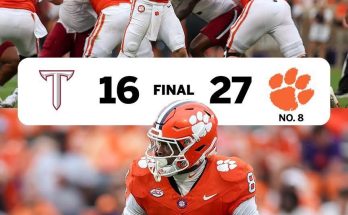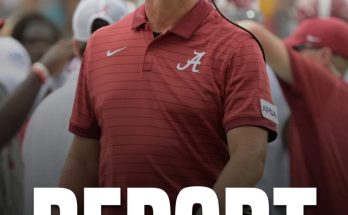The recent news from the National Rugby League (NRL) has sent shockwaves through the rugby community, sports media, and fanbases across Australia. Jesse Arthars, a highly talented and sought-after rugby league star, has made a decision that is stirring significant discussion and admiration: he has turned down a lucrative \$1.5 million offer from the Penrith Panthers, one of the league’s most dominant and successful teams, and instead committed his future to the Brisbane Broncos until 2030. This move is not just about money; it embodies loyalty, passion, and a vision for long-term growth that has fans and analysts buzzing with excitement.
At its core, this decision reflects a rare and increasingly cherished quality in professional sports—loyalty. In an era where athletes frequently switch clubs for financial gain or championship prospects, Arthars’ choice to stay with the Broncos despite a massive financial incentive elsewhere highlights the emotional and cultural ties that players can maintain with their teams. This blog post aims to explore this remarkable development in great detail, explaining the background, implications, and significance of Arthars’ decision both for the Broncos, the Panthers, the NRL, and the wider sporting landscape.
Jesse Arthars’ journey as a rugby league player has been marked by impressive performances and steady growth. A versatile backline player known for his speed, agility, and try-scoring ability, Arthars has emerged as one of the brightest young stars in the NRL. His skillset makes him a coveted asset for any club aiming to strengthen its attack and overall squad depth. Over recent seasons, he has demonstrated a consistency and flair that have drawn comparisons with some of the game’s elite talents, and it was no surprise that Penrith Panthers, fresh off premiership successes and known for their aggressive recruitment strategies, pursued him aggressively.
The Panthers’ offer of \$1.5 million was a clear statement of intent—an attempt to lure Arthars away from the Broncos and bolster their already formidable roster. Penrith’s financial capacity and winning culture have made them a magnet for top players, and their ability to attract such talent has been a significant factor in their sustained success. The money on the table was substantial, promising Arthars not only financial security but also a chance to compete at the highest level within a team that regularly vies for the title.
However, despite these tempting prospects, Arthars chose to stay with the Broncos. His commitment to the Brisbane club until 2030 speaks volumes about his personal values and aspirations. It signals a belief in the Broncos’ vision, a trust in the club’s management, and a dedication to a fanbase that has supported him since the beginning of his professional career. It also sends a powerful message that sometimes, the love for the game and loyalty to a team can outweigh even the most lucrative financial offers.
This decision has been met with widespread celebration among Broncos supporters, who view Arthars as a cornerstone of their future. The Broncos, a club with a rich history and passionate fanbase, have faced challenges in recent years in terms of performance and consistency. Securing Arthars for the long term offers a beacon of hope and stability. It shows that the club is capable of retaining its key players, building a strong culture, and planning for sustained success. For fans who have endured ups and downs, this extension represents a commitment to rebuilding and contending for premiership glory once again.
From a broader perspective, Arthars’ contract extension reflects important themes in modern professional sports. The tension between financial incentives and loyalty is a recurring storyline, and this case exemplifies how players can navigate these pressures in ways that benefit both their careers and their clubs. While professional athletes understandably seek to maximize their earnings during relatively short playing careers, Arthars’ choice reminds us that factors like club culture, team environment, family considerations, and personal goals often carry equal or greater weight.
Furthermore, Arthars’ loyalty challenges the common narrative that high-profile players are solely motivated by money or immediate success. It opens a conversation about what motivates athletes in today’s sports world—how legacy, identity, and emotional connection to a club can shape career decisions. This perspective is valuable for teams, administrators, and fans alike, as it encourages a more holistic understanding of player retention strategies and contract negotiations.
The NRL itself benefits from stories like Arthars’. When players make high-profile, long-term commitments to clubs, it enhances the league’s image and appeal. Fans can develop deeper emotional bonds with players who represent stability and continuity, which can translate to greater attendance, merchandise sales, and engagement. It also encourages competitive balance by preventing talent from clustering disproportionately in a few wealthy teams. When clubs like the Broncos can retain stars despite aggressive offers from rivals, it signals a healthy, vibrant league where competition is fostered on multiple fronts.
This situation also highlights the role of leadership within clubs. The Broncos’ management and coaching staff deserve credit for creating an environment that persuaded Arthars to stay. Their ability to communicate a compelling vision for the future, provide professional support, and foster a strong team culture is instrumental in retaining key players. It demonstrates that investment in people, culture, and infrastructure can be as critical as financial offers in player recruitment and retention.
On the flip side, the Penrith Panthers will undoubtedly be disappointed. Losing out on a player of Arthars’ caliber after offering a substantial contract will prompt reflection on their recruitment approach and strategy. However, it also reinforces the competitive nature of the NRL recruitment market. Even the most aggressive financial offers do not guarantee success if other clubs can provide an environment that aligns better with the player’s personal and professional goals.
Arthars’ commitment to the Broncos until 2030 also brings attention to the concept of long-term planning in professional sports. Ten-year contracts are rare and ambitious, signaling that the Broncos are not just thinking about the immediate future but are investing in a core group of players to build sustained success. Such a strategy requires patience and faith from all stakeholders, including players, coaches, fans, and executives. It suggests that the Broncos are confident in their trajectory and are willing to weather short-term challenges for long-term rewards.
For Jesse Arthars himself, this move provides stability and a platform to develop his career without the distraction of annual contract negotiations or uncertainty about his future. It allows him to focus on improving his game, contributing to the team’s success, and establishing himself as a leader within the club. This continuity is invaluable in a physically demanding sport like rugby league, where confidence, team chemistry, and mental focus can significantly impact performance.
Moreover, Arthars’ decision might influence other players in the NRL and beyond. When a player publicly values loyalty and long-term commitment over immediate financial gain, it sets an example that can inspire teammates and peers. It challenges the “free agency” mentality that dominates many sports, encouraging a culture where players consider broader factors when making career decisions. This can lead to stronger club identities, more cohesive teams, and a richer sporting experience for fans.
Fans have been particularly vocal in their support of Arthars’ choice. Social media has been flooded with messages celebrating his loyalty and dedication to the Broncos. For many, this move feels like a breath of fresh air amid a sporting landscape increasingly dominated by money-driven decisions. It rekindles the nostalgic ideal of players who represent their clubs with pride, staying true to the colors they wear. Such emotional connections are essential for the health and longevity of any sport, fostering a sense of community and shared identity.
The media coverage surrounding this story also underscores its significance. Analysts and commentators have praised Arthars for his maturity and foresight, noting that his decision may well be a defining moment in his career. Pundits have highlighted the positive ripple effects this extension will have on the Broncos’ squad morale and recruitment prospects. At the same time, there is a growing appreciation for the strategic acumen displayed by the Broncos’ management in securing this deal.
The financial aspect of the story should not be overlooked. Turning down \$1.5 million is a substantial sacrifice by any measure. However, it is important to recognize that Arthars is not rejecting financial security outright; rather, he is choosing to accept a contract that presumably offers him a stable and competitive package with the Broncos. This indicates a balance between financial prudence and emotional allegiance, showcasing how athletes weigh various factors in their decision-making processes.
Additionally, this story sheds light on how clubs structure contracts to appeal to players beyond just money. Factors like performance incentives, leadership opportunities, community involvement, family support, and player welfare programs play an increasingly vital role. It is likely that the Broncos’ offer included such elements, making the overall proposition attractive to Arthars beyond the dollar value.
The decision also underscores the significance of player development and trust. The Broncos have invested in Arthars’ growth from early in his career, and this relationship has evidently built a strong foundation of trust and mutual respect. This relational capital is crucial in sports, as players want to feel valued and supported by their clubs, not just as athletes but as individuals. Arthars’ extension is a testament to the positive culture cultivated within the Broncos organization.
Looking at the NRL landscape, this story could signal a shift towards more long-term player commitments and less frequent club-hopping. While free agency will always be a feature of professional sport, stories like this highlight the benefits of stability for players and teams alike. It may encourage clubs to rethink recruitment strategies, placing more emphasis on culture-building, player satisfaction, and holistic support systems.
Moreover, Arthars’ decision comes at a time when the Broncos are working hard to reclaim their position as a powerhouse in the league. They have been rebuilding their roster and coaching staff, aiming to create a competitive and sustainable team. Retaining key players like Arthars is a vital part of this process, and his loyalty could serve as a catalyst for attracting other talented players to the club. It also boosts the morale of younger players who see a clear path for growth and success within the Broncos setup.
The emotional impact on the fanbase cannot be overstated. Broncos supporters have long yearned for a player to rally behind—a figure who embodies the club’s values and aspirations. Jesse Arthars now fills that role. His long-term commitment provides a symbol of hope, resilience, and ambition that fans can celebrate and rally around. In a sport where player movement often disrupts fan loyalty, such bonds are priceless.
In conclusion, Jesse Arthars’ decision to turn down the Penrith Panthers’ \$1.5 million deal and commit to the Brisbane Broncos until 2030 is a landmark moment in the NRL. It transcends the typical narratives of sports contracts by highlighting the profound importance of loyalty, culture, and long-term vision. This move enriches the sporting world with a powerful example of a player choosing passion and loyalty over immediate financial gain, reaffirming the emotional heart of rugby league.
The implications of this decision ripple far beyond the individual or the clubs involved. It challenges conventional thinking about athlete motivations, reinforces the value of strong club cultures, and promotes the benefits of stability and long-term planning in professional sports. For fans, it rekindles the deep connection they crave with players who represent more than just a contract or a statistic—they represent identity, community, and hope.
As the Broncos and Jesse Arthars embark on this decade-long journey together, the entire NRL community will be watching closely. Will this commitment translate into premiership success? Will it inspire more players to value loyalty and long-term commitment? Regardless of the outcomes on the field, this decision already stands as a compelling and educational chapter in the story of professional rugby league, offering valuable lessons for players, clubs, and fans alike.



